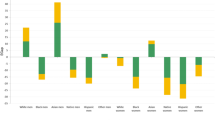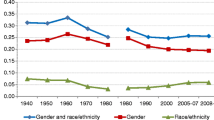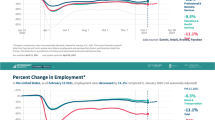Abstract
This paper uses US Census data from 1970 to 1990 to focus on “integrated” occupations—those in which men and women are approximately equally represented. We focus on the extensive variability that exists across these nominally integrated occupations, specifically their social demography and the paths by which they reach compositional sex equity. We also examine the link between occupational integration and race/sex succession, and explore the earnings consequences of working in mixed occupations. Our findings suggest that integration means quite different things at different levels of the occupational hierarchy and for the women and men integrating sex-atypical occupations.
Similar content being viewed by others
References
Albelda, Randy P. 1986 “Occupational segregation by race and gender, 1958–1981.” Industrial and Labor Relations Review 39:404–413.
Baunach, Dawn Michelle 2002 “Trends in occupational sex segregation and inequality, 1950 to 1990.” Social Science Research 31:77–98.
Bielby, William T., and James Baron 1984 “A woman's place is with other women: Sex segregation within organizations.” In Barbara Reskin (ed.), Sex Segregation in the Workplace: Trends, Explanations, and Remedies: 27–55. Washington, DC: National Academy Press.
1986 “Men and women at work: Sex segregation and statistical discrimination.” American Journal of Sociology 91:759–799.
Blackburn, Robert M., Jennifer Jarman, and Bradley Brooks 2000 “The puzzle of gender segregation and inequality: A cross-national analysis.” European Sociological Review 16:119–135.
Bradley, Harriet 1993 “Across the great divide: The entry of men into ‘women’s jobs.”' In Christine L. Williams (ed.), Doing “Women's Work”: Men in Nontraditional Occupations: 10–27. Newbury Park, CA: Sage.
Budig, Michelle J. 2002 “Male advantage and the gender composition of jobs: Who rides the glass escalator.” Social Problems 49:258–277.
Catanzarite, Lisa 2000 “Brown-collar jobs: Occupational segregation and earnings of recent-immigrant Latinos.” Sociological Perspectives 43:45–75.
2002 “Dynamics of segregation and earnings in brown-collar occupations.” Work and Occupations 29:300–345.
2003 “Race-gender composition and occupational pay desegregation.” Social Problems 50:14–37.
Catanzarite, Lisa, and Michael Bernabe Aguilera 2002 “Working with co-ethnics: Earnings penalties for Latino immigrants at Latino jobsites.” Social Problems 49:101–127.
Cohen, Philip N., and Matt L. Huffman 2003 “Occupational segregation and the devaluation of women's work across US labor markets.” Social Forces 81:881–908.
Cohn, Samuel 2000 Race, Gender, and Discrimination at Work. Boulder, CO: Westview Press.
Cotter, David A., JoAnn DeFiore, Joan M. Hermsen, Brenda M. Kowalewski, and Reeve Vanneman 1997 “All women benefit: The macro-level effect of occupational integration on gender earnings inequality.” American Sociological Review 62:714–734.
Cotter, David A., Joan M. Hermsen, and Reeve Vanneman 2003 “The effects of occupational gender segregation across race.” Sociological Quarterly 44:17–36.
de Ruijter, Judith M. P., and Matt L. Huffman 2003 “Gender composition effects in the Netherlands: A multilevel analysis of occupational wage inequality.” Social Science Research 32:312–334.
Demaris, Alfred 1992 Logit Modeling: Practical Applications, Vol. 86. Quantitative Applications in the Social Sciences. Newbury Park, CA: Sage.
Duncan, Otis Dudley, and Beverly Duncan 1957 The Negro Population of Chicago: A Study of Residential Succession. Chicago: University of Chicago Press.
England, Paula 1992 Comparable Worth: Theories and Evidence. New York: Aldine de Gruyter.
England, Paula, and Melissa S. Herbert 1993 “The pay of men in “female” occupations: Is comparable worth only for women?” In Christine L. Williams (ed.), Doing “Women's Work,” Men in Nontraditional Occupations: 28–48. Newbury Park, CA: Sage.
England, Paula, Joan M. Hermsen, and David A. Cotter 2000 “The devaluation of women's work: A comment on Tam.” American Journal of Sociology 105:1741–1760.
Gatta, Mary L. 2002 Women at Work: Achieving Parity on the Job. Trenton, NJ: New Jersey State Employment and Training Commission.
Goldin, Claudia 1990 Understanding The Gender Gap: An Economic History of American Women. New York: Oxford University Press.
Hakim, Catherine 1993 “Segregated and integrated occupations: A new approach to analysing social change.” European Sociological Review 9:289–314.
1998 Social Change and Innovation in the Labour Market: Evidence from the Census SARS on Occupational Segregation and Labour Mobility, Part-Time Work and Student Jobs, Homework and Self-Employment. Oxford: Oxford University Press.
Hartmann, Heidi 1976 “Capitalism, patriarchy, and job segregation by sex.” Signs 1:137–170.
Hodson, Randy 1983 Women's Earnings and Corporate Economic Structure. New York: Academic Press.
Huffman, Matt L. 2004 “Gender inequality across local wage hierarchies.” Work and Occupations 31:323–344.
Huffman, Matt L., and Philip N. Cohen 2004 “Occupational segregation and the gender gap in workplace authority: National versus local labor markets.” Sociological Forum 19:121–147.
Jacobs, Jerry A. 1989a “Long-term trends in occupational segregation by sex.” American Journal of Sociology 95:160–173.
1989b Revolving Doors: Sex Segregation and Women's Careers. Stanford, CA: Stanford University Press.
1999 “The sex segregation of occupations: Prospects for the 21st century.” In Gary Powell (ed.), Handbook of Gender and Work: 125–139. Thousand Oaks, CA: Sage.
Kessler-Harris, Alice 1982 Out to Work: A History of Wage Earning Women in the United States. New York: Oxford University Press.
McCall, Leslie 1998 “Spatial routes to gender wage (in)equality: Regional restructuring and wage differentials by gender and education.” Economic Geography 74:379–404.
2000 “Gender and the new inequality: Explaining the college/non-college wage gap.” American Sociological Review 65:234–255.
2001 Complex Inequality: Gender, Class, and Race in a Restructuring Economy. New York: Routledge Press.
Nelson, Robert L., and William P. Bridges 1999 Legalizing Gender Inequality: Courts, Markets, and Unequal Pay for Women in America. New York: Cambridge University Press.
Petersen, Trond, and Laurie A. Morgan 1995 “Separate and unequal: Occupation-establishment sex segregation and the gender wage gap.” American Journal of Sociology 101:329–265.
Pettigrew, Thomas F. 1969 “Racially separate or together.” Journal of Social Issues 25:43–69.
Reskin, Barbara F. 1993 “Sex segregation in the workplace.” Annual Review of Sociology 19:241–270.
Reskin, Barbara F., and Heidi Hartmann 1986 Women's Work, Men's Work: Sex Segregation on the Job. Washington, DC: National Academy Press.
Reskin, Barbara F., Debra B. McBrier, and Julie A. Kmec 1999 “The determinants and consequences of workplace sex and race composition.” Annual Review of Sociology 25:335–361.
Reskin, Barbara F., and Irene Padavic 1994 Women and Men at Work. Thousand Oaks, CA: Pine Forge Press.
Reskin, Barbara F., and Patricia A. Roos 1990 Job Queues, Gender Queues: Explaining Women's Inroads into Male Occupations. Philadelphia, PA: Temple University Press.
Roos, Patricia A., and Mary Lizabeth Gatta 1999 “The gender gap in earnings: Trends, explanations, and prospects.” In Gary Powell (ed.), Handbook of Gender and Work: 95–123. Thousand Oaks, CA: Sage.
Roos, Patricia A., and Barbara F. Reskin 1996 Trends in Occupational Sex and Race Composition, 1970–1990: Codebooks and Technical Documentation. Unpublished document, Department of Sociology, Rutgers University. New Brunswick, NJ.
Rosenfeld, Rachel A., and Arne L. Kalleberg 1990 “A cross-national comparison of the gender gap in income.” American Journal of Sociology 96:69–106.
Rosenfeld, Rachel A., and Heike Trappe 2002 “Occupational sex segregation in state socialist and market economies: Levels, patterns, and change in East and West Germany, 1980s and 1998.” In Kevin T. Leicht (ed.), The Future of Market Transition: Research in Social Stratification and Mobility: 231–267. Oxford: Elsevier Science.
Rytina, Nancy F. 1981 “Occupational segregation and earnings differences by sex.” Monthly Labor Review 104:49–53.
Rytina, Nancy F., and Suzanne M. Bianchi 1984 “Occupational reclassification and changes in distribution by gender.” Monthly Labor Review 107:11–17.
Seibert, M. Therese, Mark A. Fossett, and Dawn M. Baunach 1997 “Trends in male-female status inequality, 1940–1990.” Social Science Research 26:1–24.
Tam, Tony 1997 “Sex segregation and occupational gender inequality in the United States: Devaluation or specialized training?” American Journal of Sociology 102:1652–1692.
Tomaskovic-Devey, Donald 1993 Gender and Racial Inequality at Work: The Sources and Consequences of Job Segregation. Ithaca: NY: ILR Press.
Tomaskovic-Devey, Donald, and Sheryl Skaggs 2002 “Sex segregation, labor process organization, and gender earnings inequality.” American Journal of Sociology 108:102–128.
US Bureau of the Census 1972 Census of Population and Housing, 1970. Public Use Samples of Basic Records from the 1970 Census: Description and Technical Documentation. Washington, DC: US Bureau of the Census.
1983 Census of Population and Housing, 1980: Public Use Microdata Samples Technical Documentation. Washington, DC: US Bureau of the Census.
1993 Census of Population and Housing, 1990: Public Use Microdata Samples: United States. Washington, DC: US Bureau of the Census.
Weeden, Kim A. 1998 “Revisiting occupational sex segregation in the United States, 1910–1990: Results from a log-linear approach.” Demography 35:475–487.
Williams, Christine L., ed. 1993 Doing “Women's Work:” Men in Nontraditional Occupations. Newbury Park, CA: Sage.
Williams, L. Susan, and Wayne J. Villemez 1993 “Seekers and finders: Male entry and exit in female-dominated jobs.” In Christine L. Williams (ed.), Doing “Women's Work;” Men in Nontraditional Occupations: 64–90. Newbury Park, CA: Sage.
Author information
Authors and Affiliations
Corresponding author
Additional information
This is a revised version of a paper presented at the Annual Meetings of the American Sociological Association, Anaheim, CA, August 2001.
Rights and permissions
About this article
Cite this article
Gatta, M.L., Roos, P.A. Rethinking Occupational Integration. Sociol Forum 20, 369–402 (2005). https://doi.org/10.1007/s11206-005-6594-5
Issue Date:
DOI: https://doi.org/10.1007/s11206-005-6594-5




